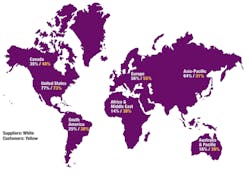Globalization is one of those politically charged words that often implies more than it actually means. From the relatively benign “the world is flat” philosophy that suggests offshore factories help stimulate U.S. imports, to the “offshoring costs American jobs” idea that everything can and should be made in the United States, everybody in manufacturing has an opinion on whether globalization is good or bad for their companies and/or their fellow citizens.
Some might suggest, in fact, that globalization is a fait accompli. As Daniel Akerson, chairman and CEO of General Motors Co. (IW 500/4) pointed out at a news conference in 2011, seven out of 10 of all GM vehicles are made outside the United States, and the trend shows no signs of stopping.
There’s nothing very new about globalization, though, a concept that basically refers to the practice of sourcing, manufacturing, transporting and distributing products outside of your native country. Its modern application predates the rise of the Internet by a good 40 years, beginning in the early 1950s when container shipping was introduced, making it possible to quickly, efficiently and economically move entire container loads onto ocean vessels at ports of call throughout the world.
As the world has gotten flatter and supply chains have gotten longer, the need for companies to follow best practices in global supply chain management has intensified. Gary Miller has a deep familiarity with such a role, having spent 40 years as vice president, global supply chain and chief procurement officer with $23 billion tire manufacturer Goodyear Tire and Rubber Co. (IW 500/54) before taking on the same role in 2008 at A. Schulman Inc. (IW 500/343), a $2.5 billion plastics manufacturer. As Miller explains it, he’s responsible for Schulman’s supply chain and procurement activities to better leverage its worldwide purchasing power, reduce materials inventories, eliminate waste and improve efficiency. The company has 35 facilities globally, with nearly 70% of its revenues derived out of the European market.
“We have global customers that we service around the world,” he says. “Europe is a very large region for us, so we have deep relationships with our customers there. As those customers expand around the world, they’re also looking for us to come with them.”
For instance, Schulman has some large customers in the German automotive market who are opening facilities in China. Consequently, Schulman is following its customers into China to manufacture and supply the same plastics products that are being used in Germany. “Now we can continue to supply them our products from Germany if we want to, but the advantage is that if they’re in China and we have manufacturing in China, then we can transfer our manufacturing technology to China and provide those parts on a local basis. It’s much better for our customers because they get our products with a much shorter supply chain. It’s much better for us because we can get our products to the customer with a shorter supply chain as well.”
A Formula for Success
Earlier this year, a factory explosion at an Evonik Industries plant in Germany dramatically reduced the amount of nylon supply available to its customers, one of those customers being A. Schulman. This could have led to a supply chain disaster, had it not been for a risk-management best practice Schulman and other plastics manufacturers follow: shifting to alternate materials and in some cases, alternate formulations.
“In some cases, we are single sourced with a raw material,” Miller says, “but we look very specifically at those products and determine how we can develop other formulations or find other materials, which can be utilized in place of that. This nylon situation is a good example. The industry was going to be extremely short of nylon based on what happened to Evonik. Fortunately, we have an active program underway with another nylon producer of a substitute material, and it gave us the ability to help the industry find an alternative that was suitable for use.”
As Miller sees it, procurement is a particularly fertile area for synergy because of the opportunities to arbitrage currency, import duties or export duties. One of the key elements of managing the procurement process, he says, is having a global communication system so that they understand what they’re buying in every region. “In regions like Asia, for instance, it helps us to identify, develop, evaluate and commercialize new sources of supply for materials that will give us a performance advantage, a cost advantage or a security of supply advantage. Those are the types of things that we’re looking for as we look at trying to find new sources of supply.”
Expansion into New Markets
When Mike Dennison, president of the High Velocity Solutions business group at $29 billion electronics contract manufacturer Flextronics International (IW 1000/141), hears the word globalization, the first thing he thinks about is speed and execution. Usually it’s tied to what his customers need relative to globalization, which could mean launching a product globally on three different continents in a six-week timeframe. “From my perspective, globalization is about speed of getting customer demands and needs met on a global basis.”
Dennison cites the example of a company with a manufacturing facility in China that wanted to expand production into Brazil. “The first thing you have to understand is that manufacturing in China is massively different from manufacturing in Brazil, in a number of ways: in how we set up our factories, in how we work with the government, in how we get product into the factories and then out of the factories as finished goods and into the hands of the consumer. And in this particular case, we needed to build a factory, fill a factory and hire a labor force in about 120 days.”
"Globilization is about speed of getting customer demands and needs met on a global basis."
-Mike Dennison, president, Flextronics High Velocity Solutions
To achieve that kind of an undertaking, Flextronics began by tapping into the experiences and brainpower of its manufacturing experts who had already done something along those lines in China, and then moving them into Brazil, where they recruited the labor pool and developed the tests and technology requirements necessary to build the product. “At the same time,” Dennison continues, “you need your supply chain people involved because that product’s components are probably going to originate or even be kitted out of the central location in China, and then need to get into Brazil in a seamless fashion.”
Meanwhile, in terms of the financial supply chain, Flextronics worked with international tax experts to make sure the expansion into Brazil was accomplished in a way that was effective for the customer to ensure they derived the benefit of local manufacturing as opposed to simply importing the product from China. And on top of that, Flextronics had to develop a brand new channel solution to handle the fulfillment end in Brazil.
“It gets to be a very complicated endeavor which, frankly, is where we start to add real value because helping a company expand into a new market is not easy to do,” Dennison observes. “You’re not going to get Brazil right unless you have the background of knowing what you’re doing in China, in this particular case.”
Though Flextronics is traditionally considered a contract manufacturer, or a provider of electronics manufacturing services, Dennison points out that these days many of their customers, especially emerging companies not typically in the hardware business, rely on Flextronics more for design services and new product introduction support.
“There’s a whole new world of companies entering into the electronics market that need a vastly different capability than the likes of HP, Dell and Cisco Systems,” he notes. “The only thing this new customer base cares about is having a product that no one else has ever seen, heard of or even thought of, like the wearable technology products that Nike is doing. We see a lot more of that type of business now than customers asking us to build 5 million cellphones that look just like a competitor’s products.”
Ensuring Reliability of Supply
In a poll of C-suite supply chain executives, analyst firm Aberdeen Group found that the growing complexity of global operations is the biggest challenge these executives face. “Supply chains that were once purely domestic have now gone international as an increasing number of shipments flow across borders and supply and demand imbalances increase,” points out Bob Heaney, senior research analyst at Aberdeen Group. But what many of these companies are discovering, he says, is that “many of the benefits derived from their finely tuned/optimized domestic supply chains are being cancelled out by their poorly performing global supply chain.”
Technology, Heaney points out, has become a key enabler in the transformation from domestic to global supply chains, particularly to gain visibility to all supply chain partners. Mike Owen, vice president, global supply chain, with $6 billion specialty chemical company The Lubrizol Corp., a Berkshire Hathaway company, would certainly concur that the right solution can provide a competitive advantage, particularly as the company executes on its growth strategy in some sizable regions – Asia-Pacific, Latin America, India – where Lubrizol has not had a large supply chain employee base.
“Reliability of supply is core to Lubrizol’s DNA,” Owen emphasizes. One of the key enablers of that reliability is the company’s global ERP system, which provides a single version of the truth throughout the world. “We not only use the same ERP system [SAP] globally, but it’s the exact same version of that ERP system in every implementation. Everything is connected and all the data is live, so it expedites the decision-making process where speed and accuracy in our business is absolutely critical.”
He offers an example to illustrate how the global ERP system helps fulfill Lubrizol’s mission to its customers. “Let’s say that, for some reason, we have a supply issue and we’re unable to get one of our key raw materials. Our one-version ERP system allows us to immediately put in mitigation plans to protect our customer. We’ll immediately know what product that raw material goes into. We’ll know the manufacturing locations where that raw material is used. We’ll know exactly how much inventory of that raw material we have on hand, how much inventory of the product we are making we have on hand, and how much is being shipped to customers at that specific time. We’ll know immediately the number of approved suppliers for that product, on a global basis. We’ll know what is shipped on a real-time basis, we’ll know it accurately and we’ll know it immediately.”
As a result, if there’s an issue with a raw material, Lubrizol personnel throughout the world will have global access to all the relevant supply chain data and will be able to put together mitigation plans that will allow the company to utilize all available inventory, all sources of supply and all manufacturing locations to protect its customers from the supply shortage.
On the risk management front, Lubrizol’s global supply chain team adheres to a formula of its own devising: “Risk” = “Likelihood of a Critical Shortage” × “Impact It Would Have.” “For Impact, we use gross profit of the raw material of the products it goes into,” Owen explains. “To determine the likelihood of a supply disruption, we work closely with our suppliers to make sure we fully understand their supply capabilities. Then we work to understand the overall market dynamics that could impact that supply. And then we also dive in to fully understand our suppliers’ business continuity plans. So we end up with very strong knowledge—not only of our suppliers but the industry as well.”
Finally, Lubrizol measures its performance using roughly 10 operational standard metrics, which are updated on a monthly basis, which include such things as: Did we ship as we promised? How long did it take us to respond and confirm the shipping date after we received the order? How accurate was our invoice? “It all gets back,” Owen stresses, “to the cornerstone that reliability of supply is key to whatever decisions Lubrizol makes.”
Percentages equal numbers of all companies having suppliers or customers in each region. Source: Aberdeen Group






